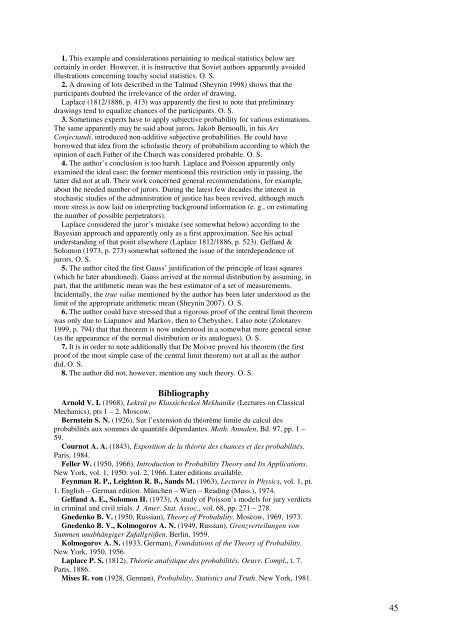1 Studies in the History of Statistics and Probability ... - Sheynin, Oscar
1 Studies in the History of Statistics and Probability ... - Sheynin, Oscar
1 Studies in the History of Statistics and Probability ... - Sheynin, Oscar
Create successful ePaper yourself
Turn your PDF publications into a flip-book with our unique Google optimized e-Paper software.
1. This example <strong>and</strong> considerations perta<strong>in</strong><strong>in</strong>g to medical statistics below arecerta<strong>in</strong>ly <strong>in</strong> order. However, it is <strong>in</strong>structive that Soviet authors apparently avoidedillustrations concern<strong>in</strong>g touchy social statistics. O. S.2. A draw<strong>in</strong>g <strong>of</strong> lots described <strong>in</strong> <strong>the</strong> Talmud (Sheyn<strong>in</strong> 1998) shows that <strong>the</strong>participants doubted <strong>the</strong> irrelevance <strong>of</strong> <strong>the</strong> order <strong>of</strong> draw<strong>in</strong>g.Laplace (1812/1886, p. 413) was apparently <strong>the</strong> first to note that prelim<strong>in</strong>arydraw<strong>in</strong>gs tend to equalize chances <strong>of</strong> <strong>the</strong> participants. O. S.3. Sometimes experts have to apply subjective probability for various estimations.The same apparently may be said about jurors. Jakob Bernoulli, <strong>in</strong> his ArsConject<strong>and</strong>i, <strong>in</strong>troduced non-additive subjective probabilities. He could haveborrowed that idea from <strong>the</strong> scholastic <strong>the</strong>ory <strong>of</strong> probabilism accord<strong>in</strong>g to which <strong>the</strong>op<strong>in</strong>ion <strong>of</strong> each Fa<strong>the</strong>r <strong>of</strong> <strong>the</strong> Church was considered probable. O. S.4. The author’s conclusion is too harsh. Laplace <strong>and</strong> Poisson apparently onlyexam<strong>in</strong>ed <strong>the</strong> ideal case; <strong>the</strong> former mentioned this restriction only <strong>in</strong> pass<strong>in</strong>g, <strong>the</strong>latter did not at all. Their work concerned general recommendations, for example,about <strong>the</strong> needed number <strong>of</strong> jurors. Dur<strong>in</strong>g <strong>the</strong> latest few decades <strong>the</strong> <strong>in</strong>terest <strong>in</strong>stochastic studies <strong>of</strong> <strong>the</strong> adm<strong>in</strong>istration <strong>of</strong> justice has been revived, although muchmore stress is now laid on <strong>in</strong>terpret<strong>in</strong>g background <strong>in</strong>formation (e. g., on estimat<strong>in</strong>g<strong>the</strong> number <strong>of</strong> possible perpetrators).Laplace considered <strong>the</strong> juror’s mistake (see somewhat below) accord<strong>in</strong>g to <strong>the</strong>Bayesian approach <strong>and</strong> apparently only as a first approximation. See his actualunderst<strong>and</strong><strong>in</strong>g <strong>of</strong> that po<strong>in</strong>t elsewhere (Laplace 1812/1886, p. 523). Gelf<strong>and</strong> &Solomon (1973, p. 273) somewhat s<strong>of</strong>tened <strong>the</strong> issue <strong>of</strong> <strong>the</strong> <strong>in</strong>terdependence <strong>of</strong>jurors. O. S.5. The author cited <strong>the</strong> first Gauss’ justification <strong>of</strong> <strong>the</strong> pr<strong>in</strong>ciple <strong>of</strong> least squares(which he later ab<strong>and</strong>oned). Gauss arrived at <strong>the</strong> normal distribution by assum<strong>in</strong>g, <strong>in</strong>part, that <strong>the</strong> arithmetic mean was <strong>the</strong> best estimator <strong>of</strong> a set <strong>of</strong> measurements.Incidentally, <strong>the</strong> true value mentioned by <strong>the</strong> author has been later understood as <strong>the</strong>limit <strong>of</strong> <strong>the</strong> appropriate arithmetic mean (Sheyn<strong>in</strong> 2007). O. S.6. The author could have stressed that a rigorous pro<strong>of</strong> <strong>of</strong> <strong>the</strong> central limit <strong>the</strong>oremwas only due to Liapunov <strong>and</strong> Markov, <strong>the</strong>n to Chebyshev. I also note (Zolotarev1999, p. 794) that that <strong>the</strong>orem is now understood <strong>in</strong> a somewhat more general sense(as <strong>the</strong> appearance <strong>of</strong> <strong>the</strong> normal distribution or its analogues). O. S.7. It is <strong>in</strong> order to note additionally that De Moivre proved his <strong>the</strong>orem (<strong>the</strong> firstpro<strong>of</strong> <strong>of</strong> <strong>the</strong> most simple case <strong>of</strong> <strong>the</strong> central limit <strong>the</strong>orem) not at all as <strong>the</strong> authordid. O. S.8. The author did not, however, mention any such <strong>the</strong>ory. O. S.BibliographyArnold V. I. (1968), Lektsii po Klassicheskoi Mekhanike (Lectures on ClassicalMechanics), pts 1 – 2. Moscow.Bernste<strong>in</strong> S. N. (1926), Sur l’extension du théorème limite du calcul desprobabilités aux sommes de quantités dépendantes. Math. Annalen, Bd. 97, pp. 1 –59.Cournot A. A. (1843), Exposition de la théorie des chances et des probabilités.Paris, 1984.Feller W. (1950, 1966), Introduction to <strong>Probability</strong> Theory <strong>and</strong> Its Applications.New York, vol. 1, 1950; vol. 2, 1966. Later editions available.Feynman R. P., Leighton R. B., S<strong>and</strong>s M. (1963), Lectures <strong>in</strong> Physics, vol. 1, pt.1. English – German edition. München – Wien − Read<strong>in</strong>g (Mass.), 1974.Gelf<strong>and</strong> A. E., Solomon H. (1973), A study <strong>of</strong> Poisson’s models for jury verdicts<strong>in</strong> crim<strong>in</strong>al <strong>and</strong> civil trials. J. Amer. Stat. Assoc., vol. 68, pp. 271 – 278.Gnedenko B. V. (1950, Russian), Theory <strong>of</strong> <strong>Probability</strong>. Moscow, 1969, 1973.Gnedenko B. V., Kolmogorov A. N. (1949, Russian), Grenzverteilungen vonSummen unabhängiger Zufallgrößen. Berl<strong>in</strong>, 1959.Kolmogorov A. N. (1933, German), Foundations <strong>of</strong> <strong>the</strong> Theory <strong>of</strong> <strong>Probability</strong>.New York, 1950, 1956.Laplace P. S. (1812), Théorie analytique des probabilités. Oeuvr. Compl., t. 7.Paris, 1886.Mises R. von (1928, German), <strong>Probability</strong>, <strong>Statistics</strong> <strong>and</strong> Truth. New York, 1981.45









